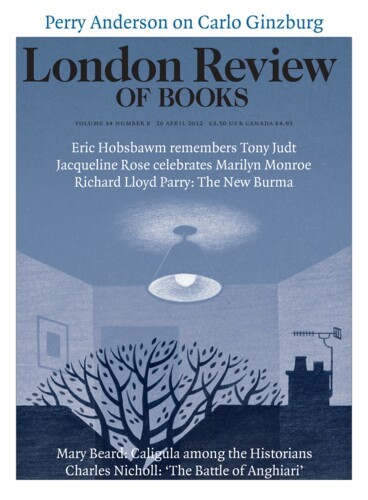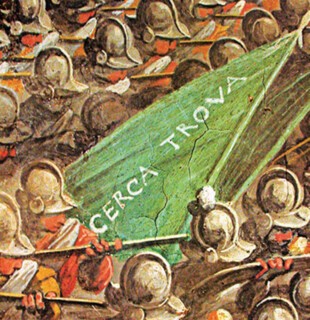Leonardo da Vinci is seldom out of the news. The story of 2011 was the Salvator Mundi, a serene and ringletted image of Christ formerly considered the work of a pupil or imitator, but now – after restoration, analysis and a substantial helping of hype – attributed to the brush of the master. No sooner had this excitement died down than the long-running saga of Leonardo’s lost mural The Battle of Anghiari was back in the headlines. At a press conference in Florence last month, Maurizio Seracini, who has spent 35 years prospecting for it, announced the findings of his latest and most ambitious probe into the walls of the Palazzo Vecchio, where it was painted in the early 16th century. Samples extracted from a recess several inches behind the sumptuously frescoed east wall of the Sala dei Cinquecento have revealed traces of a black pigment ‘very similar’ to paint found in parts of the Mona Lisa, which Leonardo was working on at the same time as the Anghiari mural, and some flakes of what may be red lacquer. This harvest of particles is microscopic but substantial – in the sense that these are substances rather than theories and conjectures. Renaissance artists had their own jealously guarded recipes for paints and glazes – Leonardo was famously expert at mixing these cocktails – and if the chemistry and spectrometry of these fragments really does match those of other Leonardo productions it would certainly be significant.
The Battle of Anghiari was commissioned by the Florentine republic in late 1503. It was intended as a large-scale fresco for the council hall of the Palazzo della Signoria (later called the Palazzo Vecchio), celebrating in suitably triumphalist terms a famous Florentine victory against the Milanese some sixty years previously. A companion fresco, The Battle of Cascina, was ordered from Michelangelo, then putting the final touches to his David. Among those involved in the commission was the civil servant and author Niccolò Machiavelli. After a year working on ideas – a cornucopia of sketches survives – and then on a full-size cartoon, Leonardo began painting in the Sala in early 1505, working on a custom-built scaffold on wheels. Among his assistants was the eccentric Tommaso Masini, aka ‘Zoroastro’, recorded in the Signoria accounts as ‘grinding colours’ for the mural. In the summer of 1506, amid recriminations from his employers, Leonardo left Florence for Milan, with the painting unfinished. Only one scene was done, probably the intended centrepiece of the mural. It showed a harrowing mêlée of terrified horses and snarling soldiers – an unflinching view of the ugliness of war which was perhaps not quite what the Signoria had in mind. Some reflection of Leonardo’s recent spell as a military engineer, in the service of the ruthless warlord Cesare Borgia, may be discernible in it.
For half a century this magnificent fragment was seen, studied, admired and copied. ‘Go up the stairs of the Sala Grande,’ Antonio Francesco Doni wrote to a friend visiting Florence, ‘and take a close look at a group of horses and men, a battle-scene by Leonardo da Vinci, and you will see something miraculous.’ That was in 1549, and is probably the latest reference to the painting as a visible artefact. If you walk up those same stairs today, and enter the great hall on the first floor, you will see any number of battle-scenes – getting on for 2000 square metres of them – but they are the work of Giorgio Vasari. The room as we now see it is the product of extensive remodelling and redecoration which began, under Vasari’s supervision, in 1555; his frescoes were painted in the 1560s. In the course of this makeover all trace of Leonardo’s Battle of Anghiari disappeared.
But what, Seracini has been asking since the mid-1970s, is the nature of that disappearance? Does it mean, as was assumed for centuries, that the mural was demolished and is therefore irrevocably lost? Or was it perhaps merely hidden from view, covered over, preserved by Vasari – a huge admirer of Leonardo – behind the surface of his own fresco? Now in his mid-sixties, Seracini is a quiet-spoken man, but his demeanour belies a steeliness which has kept him at his quest through periods of failure and isolation. Leonardo would appreciate this quality – what he called ‘hostinato rigore’, or obstinate rigour – and would also have enjoyed all the high-tech machinery being used to map the hidden strata of the Sala’s walls: thermal scanners, miniature endoscopic cameras, infra-red reflectographs, laser imaging, radar, ultrasound. Seracini has a doctorate in bio-engineering from UC San Diego, where he is still partly based, and uses technology more often associated with military, forensic, archaeological and medical applications. A self-styled ‘art-diagnostician’, and a non-fictional character in Dan Brown’s Da Vinci Code, he is an awkward maverick among the cabals of the Italian art establishment.
The composition of The Battle of Anghiari is minutely documented, but one piece of basic information is maddeningly absent or equivocal: there is nothing that tells us where in the Sala it was painted. Anyone who has stood in the room will recognise the scale of the problem. It is nearly 60 metres long and 17 metres high: you could hold an athletics meeting in there. There is evidence the mural was painted to one side of the tribune, where the chief councillors sat, but even the location of the tribune is fiercely debated among Palazzo Vecchio specialists like Johannes Wilde and Nicolai Rubinstein. Seracini’s initial forays focused without success on the west wall, but then he had his eureka moment. High on a scaffold, inspecting the upper reaches of Vasari’s Battle of Marciano, he noticed two words painted in white on a flag – letters an inch high, impossible to see from the floor without binoculars. ‘Cerca trova,’ they read: ‘Seek and you shall find.’ Analysis of a paint sample showed they were contemporary with the rest of the fresco: words put there by Vasari in about 1563. Convinced this was a deliberate message, Seracini intensified his search in this area, the south-eastern stretch of walls. He found evidence of a hidden wall behind the Vasari fresco, separated from it by a cavity some three centimetres wide. This protective pocket of air may just have been Vasari’s means of preserving the Leonardo mural. (He did something similar with Masaccio’s Holy Trinity in Santa Maria Novella, which emerged unscathed in the 19th century from behind a Vasari-built altar.) It is this occluded surface, accessed via six narrow boreholes and viewed by fibre-optic cameras, which has yielded the tantalising particles of paint and lacquer announced to the world on 12 March.
Even if this is, as Seracini believes, a first physical contact with The Battle of Anghiari, questions remain. Most pressing: what state is the painting in? On this score there are grounds for pessimism, because even before it went missing in the 1550s it was in bad condition. Though sometimes loosely called a fresco, it was not done using traditional fresco technique (watercolour and tempera on ‘fresh’ undried plaster). As with The Last Supper a decade earlier, Leonardo experimented with an oil-based mixture which would allow him time to rethink and rework as he went along. It seems – again like The Last Supper – that the mix failed to adhere: he did not do well with walls. According to a manuscript attributed to Antonio Billi, written sometime before 1520, Leonardo ‘did a cartoon of the war of the Florentines … but when he began to work from this in the Sala del Consiglio, he used a medium which did not stick [‘non serrava’], and so it remained unfinished. It was said he was deceived about the linseed oil he used, which was adulterated.’ If so, the villain of the piece may be a Florentine grocer, Francesco Nuti, who was paid in August 1505 for ‘eight pounds of linseed oil supplied to Leonardo da Vinci for the picture’. In his Lives of the Artists Vasari says: ‘He determined to paint the picture in oils, but he mixed such a thick composition for laying on the wall that as he continued his painting in the Sala it started to run. So shortly afterwards he abandoned the work, seeing that it was spoiled.’ Vasari is sometimes accused of saying this to justify his obliteration of the mural, but his comment is found in the first edition of the Lives (1550), as well as in the more widely read edition of 1568; it was thus written some years before the redecoration of the Sala was mooted, and cannot be dismissed as a case of vested interest. An early copy of the mural, a panel painting called the Tavola Doria, has some lacunae – blank gaps in the composition – which may accurately record the original in a deteriorated state.
If the painting does survive in this niche on the east wall, the possibility that it is just a giant ruined blur continues to hamper Seracini’s proposal to remove the part of Vasari’s fresco – about ten square metres – which covers it. His critics, notably the conservation group Italia Nostra, say the case is unproven and the intervention would be an act of vandalism. Politicians drag their feet, unwilling to be where the buck stops. As the former Florentine cultural councillor Rosa Giorgi put it a decade ago, ‘Vasari may not be Leonardo but he is still Vasari.’ The risks involved are certainly being exaggerated – though it sounds alarming, the detachment of frescos is fairly routine, and any number of affreschi staccati can be seen in museums and galleries. Andrea del Castagno’s Last Supper, which covers an entire wall in the refectory of Sant’Apollonia in Florence, was removed when the wonderful sinopie (underdrawings) were discovered intact beneath it; this layer was in turn detached and put on the opposite wall, and The Last Supper put back in place; both works are in good health.
Seracini now has some powerful backing – the mayor of Florence, Matteo Renzi, who has challenged central government to support this project ‘to bring this work of Leonardo’s back into the light’; and the US National Geographic Society, which has put up $250,000 in return for exclusive rights to the story. With political will, state of the art techniques and some tightly crossed fingers, we might soon be able to see what lies behind the wall. It may be ‘something miraculous’, as Antonio Doni promised back in 1549, or it may just be an empty pictorial grave. Either way, it seems time to value curiosity over caution, and to follow the advice which Vasari himself wrote on the wall: ‘Cerca trova.’
Send Letters To:
The Editor
London Review of Books,
28 Little Russell Street
London, WC1A 2HN
letters@lrb.co.uk
Please include name, address, and a telephone number.


